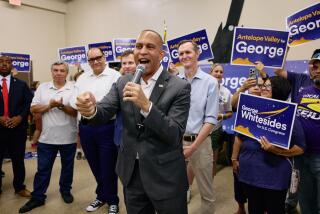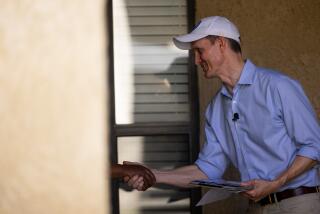Hope for a GOP resurrection is alive and well in Pasadena
The oldest Republican club in the United States rents a storefront on East Colorado Boulevard in Pasadena, next door to Resurrection Tattoo & Body Piercing.
There seems to be very little overlap in the clientele, says 86-year-old Elaine Klock, a member of the Pasadena Republican Club since the 1960s. And speaking of resurrection, don’t count the California GOP out quite yet, Klock told me on election eve. It might have its own rebirth one day, because as she put it, people tend to get wiser as they get older.
“It has to turn around. The state will never be prosperous again if there are no Republican officials at the helm,” Klock told me. “There’s no doubt in my mind about that.”
And yet a look at the state’s demographics does not suggest the California GOP, which continues to shrink, should be girding for dominance any time soon. If the party were a person, it would be on a ventilator. But that makes Klock’s unbridled optimism all the more impressive, one could argue.
Not that Klock suggested Neel Kashkari, the GOP candidate for governor, had a fighting chance of dethroning Gov. Jerry Brown in Tuesday’s election. But she was holding out hope for a Republican state controller (Ashley Swearengin) or secretary of state (Pete Peterson).
On the national front, she thought it likely that Republicans would win a majority in the U.S. Senate to go along with their advantage in the House. And speaking of the House, Klock wore a T-shirt that said “Congress Doesn’t Know Jack,” a reference to retired FBI agent Jack Orswell, who she’s hoping might upset Democratic Rep. Judy Chu in the San Gabriel Valley.
“It’s not an impossibility,” Klock said with full assurance.
Maybe not, but hardly likely either, especially given the latest numbers on voter registration in the state, which show Republicans having shrunk to 28.4% of the electorate, according to the Public Policy Institute of California. The percentage of Democrats has dropped, too, but sits at 43.4%, while independent voters now make up 21.2% of registered voters.
So what went wrong for the party of former Gov. Ronald Reagan?
No mystery there.
The state became more ethnically diverse and progressive, and the GOP became more out of step with the majority on a range of issues, including abortion and immigration. The rise of the tea party and defections by libertarians didn’t help.
The result is that two months before the election, 75% of likely California voters could not name Brown’s opponent in the governor’s race. Kashkari, an underfunded political novice, barely beat a primary foe who was a tea party poster boy and once got stopped carrying a loaded gun through airport security.
So how does the GOP climb out of this hole?
“We need candidates who look like the modern Republican, and I think you’ll see that coming over the years,” said Lynn Gabriel, president of the Pasadena Republican Club, which was founded in 1884 and was honored by President Reagan on its 100th anniversary.
But who is the modern Republican?
Kashkari, for one, said Gabriel. And then she pointed to the woman next to her, Michelle Martinez, another GOP stalwart who dropped by the campaign office to meet with me.
“The old guys are dying off,” Gabriel said of the prototypical white males who dominated the California GOP for decades, “and we are now recruiting people who look like Michelle for office.”
Martinez is a daughter of Peruvian immigrants and a member of the Altadena Town Council.
“I have 19 nephews and nieces who want to know why Auntie’s a Republican,” said Martinez, an accountant whose answer is that the GOP’s pro-business, low-tax agenda is good for California, and so is the idea that you can create your own opportunities with hard work.
Martinez said she is definitely interested in recruiting more voters to the cause and letting them know that, whatever they may have thought, she represents “what the Republican Party looks like.”
Except that it doesn’t. And that’s a problem in a state that’s half brown and very blue.
Among likely voters, 10% of Latinos, 10% of Asians and 1% of African Americans are registered Republicans.
“Where’d you get those numbers?” demanded Klock.
The Public Policy Institute of California, as a matter of fact. And I’m not trying to talk the GOP out of existence, by the way. A good honest difference of opinion can be a healthy thing when making the hard public policy choices, and that doesn’t exist in a one-party state.
“I think we’re going to see a turn,” said Gabriel. “I think young people in their 30s are going to wake up and realize the policies of our country in the last generation have not favored them at all.”
If that happens in California, it’s probably decades away, given current trend lines.
But Klock isn’t waiting around. A smattering of people had entered the office to pick up precinct packets so they could hit the phones and get out the vote.
“Is the interview over?” Klock asked, chiding me for keeping her from her job as chair of the campaign operation.
If I was looking for someone who’d given up hope on the GOP, I was looking at the wrong person, as Klock made clear. And by the way, said another die-hard, a low turnout could mean a higher concentration of older, more conservative voters, which could change the outlook completely.
If Ron Nehring didn’t get elected lieutenant governor, Klock said, it would be “so sad. Criminal almost.”
As for Kashkari, “He’s an excellent candidate. Have you heard him at all?”
I don’t know, as I’m writing this, what the outcome will be in Tuesday’s election. But no matter what may have happened, the dream of a resurgent California GOP will live on in Pasadena, right next door to Resurrection Tattoo.
More to Read
Sign up for Essential California
The most important California stories and recommendations in your inbox every morning.
You may occasionally receive promotional content from the Los Angeles Times.











